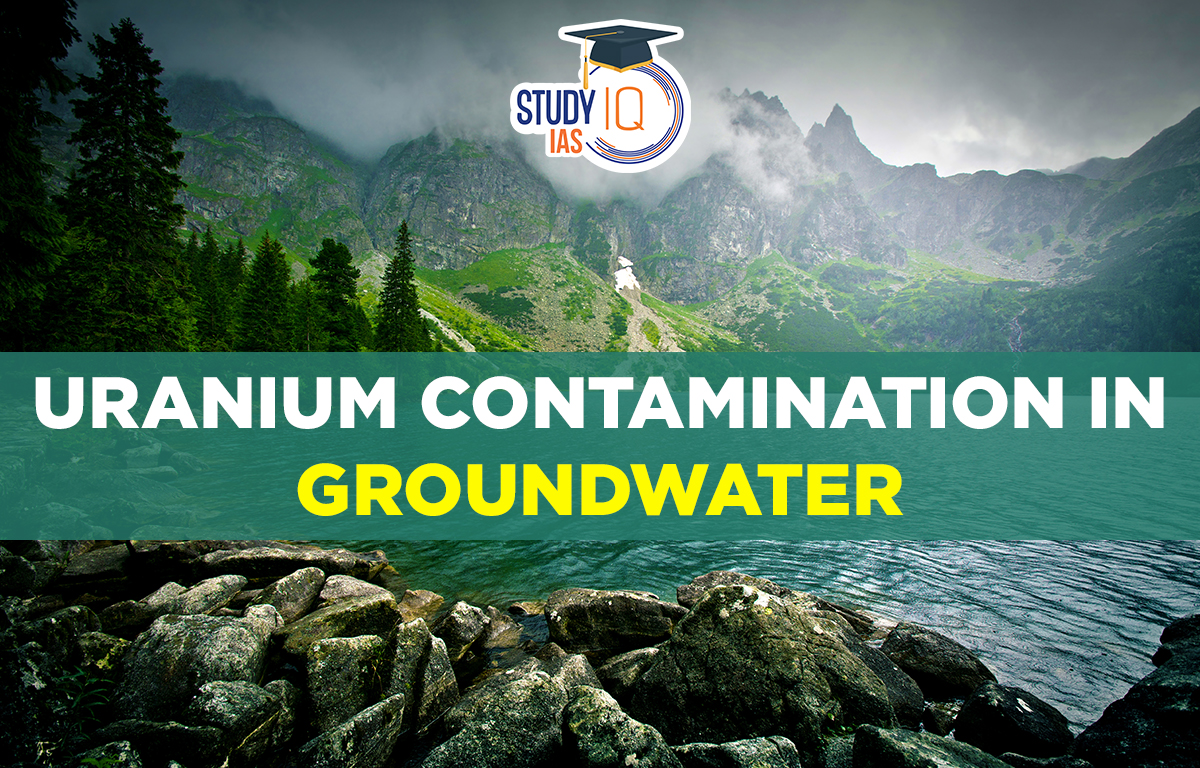Table of Contents
More on Uranium Contamination in Groundwater
- Uranium concentrations in India’s shallow groundwater range from 0-532 parts per billion (ppb).
- Uranium concentration is found to be within safe limits in 13 states and none of the samples collected from Kerala had its presence.
- Twelve Indian states have uranium levels beyond permissible limits in their groundwater.
- State Wise: Punjab is the worst-affected state in terms of the percentage of wells found to have uranium concentration.
- Uranium presence in Punjab’s groundwater is found to be 17.7 times more than the safe limit prescribed by WHO.
- Other State: Haryana is the second state in terms of uranium prevalence in groundwater.
- Groundwater in Uttar Pradesh, Rajasthan and Delhi was found to have a toxic concentration of uranium.
- Uranium concentration was found to be higher than the threshold level in localised pockets of seven other states— Madhya Pradesh, Tamil Nadu, Chhattisgarh, Gujarat, Odisha, Telangana and Bihar.
- Silver Lining: In a 2019 assessment, groundwater in 18 states was found to be contaminated with uranium.
- This year, uranium levels in six states — Andhra Pradesh, Himachal Pradesh, Maharashtra, Goa, Karnataka and West Bengal — are currently upgraded to ‘within the prescribed limits’ zone.
Drinking Water Standards for Uranium
- WHO have set drinking water standards for Uranium concentration in drinking water at 30 μg/L.
- The Atomic Energy Regulatory Board, India has prescribed the maximum limit of Uranium in drinking water at 60 μg/L (ppb).
- Bureau of Indian Standards (BIS)Indian Standard IS 10500: 2012 for Drinking Water specification has specified the maximum acceptable limits for radioactive residues as alpha and beta emitters, values in excess of which render the water not suitable.
About Uranium
- Uranium is a primordial and heaviest naturally occurring radioactive element that occurs in dispersed state in the earth’s crust. It is commonly present in lignite, monazite and phosphate rocks.
- Uranium found in bedrock, and deep bedrock aquifers are much more probable to have raised uranium amounts than shallow wells.
Causes of Uranium Contamination of Groundwater
| Causes | Details |
| Geogenic (naturally occurring) Processes |
|
| Man-Made Factors |
|
Health Impact of Uranium Contamination
- Kidney ailments: Elevated levels of uranium from any source, including drinking water, can increase a person’s risk of kidney damage.
- Bone deformity: Consumption of drinking water contaminated with uranium can also cause deformity of bones and liver.
- Cancer risk: Uranium can decay into other radioactive substances, such as radium, which can cause cancer with extensive exposures over a long enough period of time.
Way Forward
- Remedial strategies: Methods to reduce the amount of uranium mixing with groundwater:
- Redox Technologies: These technologies attempt to reduce oxidation that triggers leaching of uranium in aquifers.
- Co-precipitated Iron Oxy-hydroxide: This technology gives only short term results and leads to temporary stabilisation and the reaction is reversed as the precipitate ages.
- Phosphate Precipitation Technologies: These technologies apply and modify phosphate with uranyl (uranium VI) forms to remove soluble uranium and prevent further dissolution of uranium.
- Flushing Technologies: This uses a variety of leaching solutions to dissolve solid-phase uranium and hydraulic extraction techniques to remove the soluble uranium.
- Other methods include:
- Adsorption or ion exchange
- Reactive sorption
- Precipitation
- Reverse osmosis
- Stripping
- Inclusion of uranium monitoring in the current water quality monitoring program in India.
- More research on health risks associated with areas having high uranium contamination of water and soil.
- Treatment of groundwater contaminated with uranium for safe drinking.
Central Ground Water Board (CGWB)
- It is a subordinate office of the Ministry of Jal Shakti, Department of Water Resources, River Development and Ganga Rejuvenation.
- It has been constituted under Section 3(3) of the ‘Environment (Protection) Act, 1986’ for the purpose of regulation and control of ground water development and management in the Country.
- It is the National Apex Agency entrusted with the responsibilities of providing scientific inputs for management, exploration, monitoring, assessment, augmentation and regulation of ground water resources of the country.


 TALASH Initiative: Objective, Key Featur...
TALASH Initiative: Objective, Key Featur...
 Custodial Deaths in India, Types, Issues...
Custodial Deaths in India, Types, Issues...
 MPPSC FSO Recruitment Notification 2025 ...
MPPSC FSO Recruitment Notification 2025 ...





















